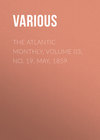Kitabı oku: «The Atlantic Monthly, Volume 03, No. 19, May, 1859», sayfa 6
The Big House, I found, was full of legends of the Pine Rats. This extraordinary race of beings are lineal descendants of the New Jersey Tories, who, during the Revolution, made the Pines their refuge, whence they sallied in perpetual forays against the farms and dwellings of the partisans of the opposite cause. Several hundreds of these fanatical desperadoes made the forest their home, and laid waste the surrounding townships by their sudden raids. Most barbarous cruelties were practised on both sides, in the contests which continually took place between Whigs and Tories, and the unnatural seven-years' war possessed nowhere darker features than in the neighborhood of the New Jersey Pines. Remains of these forest-freebooters are still discovered from time to time, in the process of clearing the woods, and unmistakable relics are occasionally met with in the denser portions of the forest, which must have been comparatively open eighty years ago.
The degraded descendants of these Tories constitute the principal difficulty with which a proprietor in this region has to contend. Completely besotted and brutish in their ignorance, they are incapable of obtaining an honest living, and have supported themselves, from a time which may be called immemorial, by practising petty larceny on an organized plan. The Pine Rat steals wood, steals game, steals cranberries, steals anything, in fact, that his hand can be laid upon; and woe to the property of the man who dares attempt to restrain him! A few weeks may, perhaps, elapse, after the tattered savage has received a warning or a reprimand, and then a column of smoke will be seen stealing up from some quarter in the forest;—he has set the woods on fire! Conflagrations of this kind will sometimes sweep away many hundreds of acres of the most valuable timber; while accidental fires are also of frequent occurrence. When indications of a fire are noticed, every available hand—men, women, and children alike—is hurried to the spot for the purpose of "fighting" it. Getting to leeward of the flames, the "fighters" kindle a counter-conflagration, which is drawn or sucked against the wind to the part already burning, and in this manner a vacant space is secured, which proves a barrier to the flames. Dexterity in fighting fires is a prime requisite in a forest overseer or workman.
"And now, something about Leeds's devil!" I said to my friend, after satisfactory definition of the Pine Rat; "what fiend may he be, if you please?"
"I will answer,—I will tell you," replies Mr. B. "There lived, in the year 1735, in the township of Burlington, a woman. Her name was Leeds, and she was shrewdly suspected of a little amateur witchcraft. Be that as it may, it is well established, that, one stormy, gusty night, when the wind was howling in turret and tree, Mother Leeds gave birth to a son, whose father could have been no other than the Prince of Darkness. No sooner did he see the light than he assumed the form of a fiend, with a horse's head, wings of bat, and a serpent's tail. The first thought of the newborn Caliban was to fall foul of his mother, whom he scratched and bepommelled soundly, and then flew through the window out into the village, where he played the mischief generally. Little children he devoured, maidens he abused, young men he mauled and battered; and it was many days before a holy man succeeded in repeating the enchantment of Prospero. At length, however, Leeds's devil was laid,—but only for one hundred years.
"During an entire century, the memory of that awful monster was preserved, and, as 1835 drew nigh, the denizens of Burlington and the Pines looked tremblingly for his rising. Strange to say, however, no one but Hannah Butler has had a personal interview with the fiend; though, since 1835, he has frequently been heard howling and screaming in the forest at night, to the terror of the Rats in their lonely encampments. Hannah Butler saw the devil, one stormy night, long ago; though some skeptical individuals affirm, that very possibly she may have been led, under the influence of liquid Jersey lightning, to invest a pine-stump, or, possibly, a belated bear, with diabolical attributes and a Satanic voice. However that may be, you cannot induce a Rat to leave his hut after dark,—nor, indeed, will you find many Jerseymen, though of a higher order of intelligence, who will brave the supernatural terrors of the gloomy forest at night, unless secure in the strength of numbers."
The Pine Rat, in his vocation as a picker-up of every unconsidered trifle, is an adept at charcoal-burning, on the sly. The business of legitimate charcoal-manufacture is also largely practised in the Pines, although the growing value of wood interferes sadly with the coalers. Here and there, however, a few acres are marked out every year for charring, and the coal-pits are established in the clearing made by felling the trees. The "coaling," as it is technically termed, is an assemblage of "pits," or piles of wood, conical in form, and about ten feet in height by twenty in diameter. The wood is cut in equal lengths, and is piled three or four tiers high, each log resting on the end of that below it, and inclining slightly inwards. An opening is left in the centre of the pile, serving as a chimney; and the exterior is overlaid with strips of turf, called "floats," which form an almost air-tight covering. When the pile is overlaid, fire is set at various small apertures in the sides, and when the whole "pit" is fairly burning, the chimney is closed, in order to prevent too rapid combustion, and the whole pile is slowly converted into charcoal. The application of the term "pit" to these piles is worthy of remark. It is due, of course, to the fact, that for centuries it was customary to burn charcoal in excavated pits, until it was discovered that gradual combustion could be as well secured by another and less tedious method.
The Pine Rat glories in his surreptitious coal-pits. In secluded portions of the forest, he may continually be discovered pottering over a "coaling," for which he has stolen the wood. This, indeed, is his only handicraft,—the single labor to which he condescends or is equal. Two or three men sometimes band together and build themselves huts after the curious fashion peculiar to the Rat, namely, by piling sticks or branches in a slope on each side of some tall pine, so that a wigwam, with the trunk of the tree in the centre, is constructed. Inside this triangular shelter—the idea of which was probably borrowed from the Indians—the Pine Rat ensconces himself with his whiskey-bottle at night, crouching in dread of the darkness, or of Leeds's devil, aforesaid. In this respect he singularly resembles the Bohemian charcoal-burner, who trembles at the thought of Rübezahl, that malicious goblin, who has an army of mountain-dwarfs and gnomes at his command. So long as the sunlight inspires our Rat with confidence, however, he will work at his coal-pit, while one comrade is away in the forest, snaring game, and another has, perhaps, been dispatched to the precincts of civilization with his wagon-load of coal. Yes! the Pine Rat sometimes treads the streets of cities,—nay, even extends his wanderings to the banks of the Delaware and the Hudson, to Philadelphia and Trenton, to Jersey City and New York. Then, who so sharp as the grimy tatterdemalion, who passes from street to street and from house to house, with his swart and rickety wagon, and his jangling bell, the discordant clangor of which, when we hear it, calls up horrible recollections of the bells that froze our hearts in plague-stricken cities of other lands, when doomed galley-slaves and forçats wheeled awful vehicles of putrefaction through the streets, clashing and clinking their clamorous bells for more and still more corpses, and foully jesting over the Death which they knew was already upon them! But the long-drawn, monotonous, nasal cry of the charcoal-vender—who has not heard it?—"Cha-r-coa'! Cha-r-coa'!"—is more cheerful than the demoniac laughter of the desperate galley-slaves, and his bell sounds musically when we hear it and think of theirs. Sometimes a couple of these peregrinants may be seen to encounter each other in the streets, and straightway there is an adjournment to the nearest bar-room, where the most scientific method of "springing the arch" is discussed over a glass of whiskey, at three cents the quart. Springing the arch, though few may be able to interpret the phrase, is a trick by which every housewife has suffered. It is the secret of piling the coal into the measure in such a manner as to make the smaller quantity pass for the larger, or, in other words, to make three pecks go for a bushel. So the Pine Rat vindicates his claim to a common humanity with all the rest of us men and women; for have not we all our secret and most approved method of springing the arch,—of palming off our three short pecks for a full and bounteous imperial bushel? Ah, yes! brothers and sisters, whisper it, if you will, below your breath, but we all can do the Pine Rat's trick!
We shall not suffer his company much longer in this world,—poor, neglected, pitiable, darkened soul that he is, this fellow-citizen of ours. He must move on; for civilization, like a stern, prosaic policeman, will have no idlers in the path. There must be no vagrants, not even in the forest, the once free and merry greenwood, our policeman-civilization says; nay, the forest, even, must keep a-moving! We must have farms here, and happy homesteads, and orchards heavy with promise of cider, and wheat golden as hope, instead of silent aisles and avenues of mournful pine-trees, sheltering such forlorn miscreations as our poor cranberry-stealing friends! Railways are piercing the Pines; surveyors are marking them out in imaginary squares; market-gardeners are engaging land; and farmers are clearing it. The Rat is driven from point to point, from one means of subsistence to another; and shortly, he will have to make the bitter choice between regulated labor and starvation clean off from the face of the earth. There is no room for a gypsy in all our wide America! The Rat must follow the Indian,—must fade like breath from a window-pane in winter!
In fact, the forest, left so long in its aboriginal savagery, is about to be regenerated. A railroad is to be constructed, this year, which will place Hanover and the centre of the forest within one hour's travel of Philadelphia; and it is scarcely too much to anticipate, that, within five years, thousands of acres, now dense with pines and cedars of a hundred rings, will be laid out in blooming market-gardens and in fields of generous corn. Such little cultivation as has hitherto been attempted has been attended by the most astonishing results; and persons have actually returned from the West and South, in order to occupy farms in the neighborhood of Hanover.
In one respect c'est dommage; one is grieved to part with the game that is now so plentiful in the Pines. Owing to the beneficent provision of the laws of New Jersey, which stringently forbid every description of hunting in the State during alternate periods of five years, game of all kinds has an opportunity to multiply; and at the termination of the season of rest, in October, 1858, there was some noble hunting in the neighborhood of Hanover. Five years hence, bears and deer will be a tradition, panthers and raccoons a myth, partridges and quails a vain and melancholy recollection, in what shall then be known as what was once the Pines.
* * * * *
THE LAST BIRD
Little Bird that singest
Far atop, this warm December day,
Heaven bestead thee, that thou wingest,
Ere the welcome song is done, thy way
To more certain weather,
Where, built high and solemnly, the skies,
Shaken by no storm together,
Fixed in vaults of steadfast sapphire rise!
There, the smile that mocks us
Answers with its warm serenity;
There, the prison-ice that locks us
Melts forgotten in a purple sea.
There, thy tuneful brothers,
In the palm's green plumage waiting long,
Mate them with the myriad others,
Like a broken rainbow bound with song.
Winter scarce is hidden,
Veiled within this fair, deceitful sky;
Fly, ere, from his ambush bidden,
He descend in ruin swift and nigh!
By the Summer stately,
Truant, thou wast fondly reared and bred:
Dost thou linger here so lately,
Knowing not thy beauteous friend is dead,—
Like to hearts that, clinging
Fervent where their first delight was fed,
Move us with untimely singing
Of the hopes whose blossom-time is sped?
Beauties have their hour,
Safely perched on the Spring-budding tree;
For the ripened soul is trust and power,
And, beyond, the calm eternity.
* * * * *
THE UTAH EXPEDITION:
ITS CAUSES AND CONSEQUENCES
[Concluded.]
On the 3d of July, the Commissioners started on their return to the States. During their stay at Salt Lake City, the doubt which they had been led to entertain of the wisdom of the policy which they were the agents to carry out, had ripened into a firm conviction.
The people who were congregated on the eastern shore of Lake Utah did not begin to repair to their homes until the army had marched thirty or forty miles away from the city; and even then there was a secrecy about their movements which was as needless as it was mysterious. They returned in divisions of from twenty to a hundred families each. Their trains, approaching the city during the afternoon, would encamp on some creek in its vicinity until midnight, when, if intended for the northern settlements, they would pass rapidly through the streets, or else make a circuit around the city-wall. August arrived before the return was completed.
Morning after morning, one square after another was seen stripped of the board barricades which had sheltered windows and doors from intrusion. In front of every gateway wagons were emptying their loads of household furniture. The streets soon lost their deserted aspect, though for many days the only wayfarers were men,—not a woman being visible, except, by chance, to the profane eyes of the invaders. It was near the end of July before a single house was rented except to the intimate associates of the Governor. Up to that time, those Gentiles who did not follow the army to its permanent camp bivouacked on the public squares. By a Church edict, all Mormons were forbidden to enter into business transactions with persons outside their sect without consulting Brigham Young, whose office was beset daily by a throng of clients beseeching indulgences and instruction. Immediately after his return to the city, however, he secluded himself from public observation, never appearing in the streets, nor on the balconies of his mansion-house. He even encompassed his residence with an armed guard.
Gradually, nevertheless, the necessities of the people induced a modification of this system of non-intercourse. The Gentile merchants, who were present with great wagon-trains containing all those articles indispensable to the comfort of life, of which the Mormons stood so much in need, refused to open a single box or bale until they could hire storehouses. The permission was at length accorded, and immediately the absolute external reserve of the people began to wear away. Both sexes thronged to the stores, eager to supply themselves with groceries and garments; but there they experienced a wholesome rebuff, for which some of them were not entirely unprepared. The merchants refused to receive the paper of the Deseret Currency Association with which the Territory was flooded; and its notes were depreciated instantly by more than fifty per cent. Many of the people were driven to barter cattle and farm-produce for the articles they needed; and for the first time since the establishment of the Church in Utah an audible murmur arose among its adherents against its exactions. The sight of their neglected farms was also calculated to bring the poorer agriculturists to sober reflection. They perceived that the army, which they had been taught to believe would commit every conceivable outrage, was, on the contrary, demeaning itself with extreme forbearance and even kindness toward them, and was supplying an ampler market for the sale of their produce than they had enjoyed since the years when the overland emigration to California culminated. Nevertheless, their regrets, if entertained at all, found no public and concerted utterance. The authority of the Church exacted a sullen demeanor toward all Gentiles.
The 24th of July, the great Mormon anniversary, was suffered to pass without celebration; but its recurrence must have suggested anxious thoughts and bitter recollections to a great part of the population. When they remembered their enthusiastic declaration of independence only one year before, the warlike demonstrations which followed it, the prophecies of Young that the Lord would smite the army as he smote the hosts of Sennacherib, the fever of hate and apprehension into which they had been worked, and contrasted that period of excitement with their present condition, they must, indeed, have found abundant material for meditation. By the emigration southward they had lost at least four months of the most valuable time of the year. Their families had been subjected to every variety of exposure and hardship. Their ready money had been extorted from them by the Currency Association, or consumed in the expenses of transporting their movables to Lake Utah. And more than all, the fields had so suffered by their absence, that the crops were diminished to at least one-half the yield of an ordinary year. To a community the mass of which lives from hand to mouth, this was a most serious loss.
Almost all agriculture in Utah is carried on by the aid of irrigation. From April till October hardly a shower falls upon the soil, which parches and cracks in the hot sunshine. The settlements are all at the base of the mountains, where they can take advantage of the brooks that leap down through the cañons. They are, therefore, necessarily scattered along the line of the main Wahsatch range, from the Roseaux River, which flows into the Salt Lake from the north, to the Vegas of the Santa Clara,—a distance of nearly four hundred miles. The labor expended in ditching has been immense, but it has been confined wholly to tapping the smaller streams.
By damming the Jordan in Salt Lake Valley and the Sevier in Parawan Valley, and distributing their water over the broad bottom-lands, on which the only vegetation now is wild sage and greasewood, the area of arable ground might be quintupled; and any considerable increase of population will render such an undertaking indispensable; for the narrow strip which is fertilized by the mountain-brooks yields scarcely more than enough to supply the present number of inhabitants. Nowhere does it exceed two or three miles in breadth, except along the eastern shore of Lake Utah, where it extends from the base of the mountains to the verge of the lake.
Almost all cereals and vegetables attain the utmost perfection, rivalling the most luxuriant productions of California. Within the last few years the cultivation of the Chinese sugar-cane has been introduced, and has proved successful. In Salt Lake City considerable attention is paid to horticulture. Peaches, apples, and grapes grow to great size, at the same time retaining excellent flavor. The grape which is most common is that of the vineyards of Los Angeles. In the vicinity of Provo an attempt has been made to cultivate the tea-plant; and on the Santa Clara several hundred acres have been devoted to the culture of cotton, but with imperfect success. Flax, however, is raised in considerable quantity. The fields are rarely fenced with rails, and almost never with stones. The dirt-walls by which they are usually surrounded are built by driving four posts into the ground, which support a case, ten or twelve feet in length, made of boards. This is packed full of mud, which dries rapidly in the intense heat of a summer noon. When it is sufficiently dry to stand without crumbling, the posts are moved farther along and the same operation is repeated.
The country is not dotted with farmhouses, like the agricultural districts of the East. The inhabitants all live in towns, or "forts," as they are more commonly called, each of which is governed by a Bishop. These are invariably laid out in a square, which is surrounded by a lofty wall of mere dirt, or else of adobe. In the smaller forts there are no streets, all the dwellings backing upon the wall, and inclosing a quadrangular area, which is covered with heaps of rubbish, and alive with pigs, chickens, and children. The same stream which irrigates the fields in the vicinity supplies the people with water for domestic purposes. There are few wells, even in the cities. Except in Salt Lake City and Provo, no barns are to be seen. The wheat is usually stored in the garrets of the houses; the hay is stacked; and the animals are herded during the winter in sheltered pastures on the low lands.
All the people of the smaller towns are agriculturists. In none of them is there a single shop. In Provo there are several small manufacturing establishments, for which the abundant water-power of the Timpanogas River, that tumbles down the neighboring cañon, furnishes great facilities. The principal manufacturing enterprise ever undertaken in the Territory—that for the production of beet-sugar—proved a complete failure. A capital advanced by Englishmen, to the amount of more than one hundred thousand dollars, was totally lost, and the result discouraged foreigners from all similar investments. Rifles and revolvers are made in limited number from the iron tires of the numerous wagons in which goods are brought into the Valley. There are tanneries, and several distilleries and breweries. In the large towns there are many thriving mechanics; but elsewhere even the blacksmith's trade is hardly self-supporting, and the carpenters and shoemakers are all farmers, practising their trades only during intervals from work in the fields.
The deficiency of iron, coal, and wood is the chief obstacle to the material development of Utah. No iron-mines have been discovered, except in the extreme southern portion of the Territory; and the quality of the ore is so inferior, that it is available only for the manufacture of the commonest household utensils, such as andirons. The principal coal-beds hitherto found are in the immediate vicinity of Green River. There are several sawmills, all run by water-power, scattered among the more densely-wooded cañons; but they supply hardly lumber enough to meet the demand,—even the sugar-boxes and boot-cases which are thrown aside at the merchants' stores being eagerly sought after and appropriated. The most ordinary articles of wooden furniture command extravagant prices.
Nowhere is the absence of trees, the utter desolation of the scenery, more impressive than in a view from the southern shore of the Great Salt Lake. The broad plain which intervenes between its margin and the foot of the Wahsatch Range is almost entirely lost sight of; the mountain-slopes, their summits flecked with snow, seem to descend into water on every side except the northern, on which the blue line of the horizon is interrupted only by Antelope Island. The prospect in that direction is apparently as illimitable as from the shore of an ocean. The sky is almost invariably clear, and the water intensely blue, except where it dashes over fragments of rock that have fallen from some adjacent cliff, or where a wave, more aspiring than its fellows, overreaches itself and breaks into a thin line of foam. Through a gap in the ranges on the west, the line of the Great Desert is dimly visible. The beach of the lake is marked by a broad belt of fine sand, the grains of which are all globular. Along its upper margin is a rank growth of reeds and salt grass. Swarms of tiny flies cover the surface of every half-evaporated pool, and a few white sea-gulls are drifting on the swells. Nowhere is there a sign of refreshing verdure except on the distant mountainsides, where patches of green grass glow in the sunlight among the vast fields of sage.
The buildings throughout the entire Territory are, almost without exception, of adobe. The brick is of a uniform drab color, more pleasing to the eye than the reddish hue of the adobes of New Mexico or the buff tinge of many of those in California. In size it is about double that commonly used in the States. The clay, also, is of very superior quality. The principal stone building in the Territory is the Capitol, at Fillmore, one hundred and fifty miles south of Salt Lake City. The design of the architect is for a very magnificent edifice in the shape of a Greek cross, with a rotunda sixty feet in diameter. Only one wing has been completed, but this is spacious enough to furnish all needful accommodation. The material is rough-hammered sandstone, of an intense red.
The plan of Salt Lake City is an index to that of all the principal towns. It is divided into squares, each side of which is forty rods in length. The streets are more than a hundred feet wide, and are all unpaved. There is not a single sidewalk of brick, stone, or plank. The situation is well chosen, being directly at the foot of the southern slope of a spur which juts out from the main Wahsatch range. Less than twenty miles from the city, almost overshadowing it, are peaks which rise to the altitude of nearly twelve thousand feet, from which the snow of course never disappears. But during the summer months, when scarcely a shower falls upon the valley, its drifts become dun-colored with dust from the friable soil below, and present an aspect similar to that of the Pyrenees at the same season. During most of the year, the rest of the mountains which encircle the Valley are also capped with snow. The residences of Young and Kimball are situated on almost the highest ground within the city-limits, and the land slopes gradually down from them to the south, east, and west. This inclination suggested the mode of supplying the city with water. A mountain-brook, pure and cold, bubbling from under snow-drifts, is guided from this highland down the gently sloping streets in gutters adjoining both the sidewalks. A municipal ordinance imposes severe penalties on any one who fouls it. Young's buildings and gardens occupy an entire square, ten acres in extent, as do also Kimball's. They consist, first, of the Mansion, a spacious two-storied building, in the style of the Yankee-Grecian villas which infest New England towns, with piazzas supported by Doric columns, and a cupola which is surmounted by a beehive, the peculiar emblem of the Mormons, although there is not a single honey-bee in the Territory. This, like all its companions, is of adobe, but it is coated with plaster, and painted white. Next to it is a small building, used formerly as an office, in which the temporal business of the Governor was transacted. By its side stands another office, on the same model, but on a larger scale, devoted to the business of the President of the Church. These are connected by passage-ways both with the Mansion and with the Lion-House, which is the most westerly of the group, and is the finest building in the Territory, having cost nearly eighty thousand dollars. Like both the offices, it stands with a gable toward the street, and the plaster with which it is covered has a light buff tinge. The architecture is Elizabethan. Above a porch in front is the figure of a recumbent lion, hewn in sandstone. On each of the sides, which overlook the gardens, ten little windows project from the roof just above the eaves. The whole square is surrounded by a wall of cobblestones and mortar, ten or twelve feet in height, strengthened by buttresses at intervals of forty or fifty feet. Massive plank gates bar the entrances. In one corner is the Tithing-Office, where the faithful render their reluctant tribute to the Lord. Only the swift city-creek intervenes between this square and Kimball's, which is encompassed by a similar wall. His buildings have no pretensions to architectural merit, being merely rough piles of adobe scattered irregularly all over the grounds.
The Temple Square is in the immediate neighborhood, and is of the same size. It is inclosed by a wall even more massive than the others, plastered and divided into panels. Near its southwestern corner stands the Tabernacle, a long, one-storied building, with an immense roof, containing a hall which will hold three thousand people. There the Mormon religious services are conducted during the winter months; but throughout the summer the usual place of gathering to listen to the sermons is in "boweries," so called, which are constructed by planting posts in the ground and weaving over them a flat roof of willow-twigs. An excavation near the centre of the square, partially filled with dirt previously to the exodus to Provo, marks the spot where the Temple is to rise. It is intended that this edifice shall infinitely surpass in magnificence its predecessor at Nauvoo. The design purports to be a revelation from heaven, and, if so, must have emanated from some one of the Gothic architects of the Middle Ages whose taste had become bewildered by his residence among the spheres; for the turrets are to be surmounted by figures of sun, moon, and stars, and the whole building bedecked with such celestial emblems. Only part of the foundation-wall has yet been laid, but it sinks thirty feet deep and is eight feet broad at the surface of the ground. Its length, according to the heavenly plan, is to be two hundred and twenty feet, and its width one hundred and fifty feet. Beside the Tabernacle and the incipient Temple, the only considerable building within the square is the Endowment-House, where those rites are celebrated which bind a member to fidelity to the Church under penalty of death, and admit him to the privilege of polygamy.










